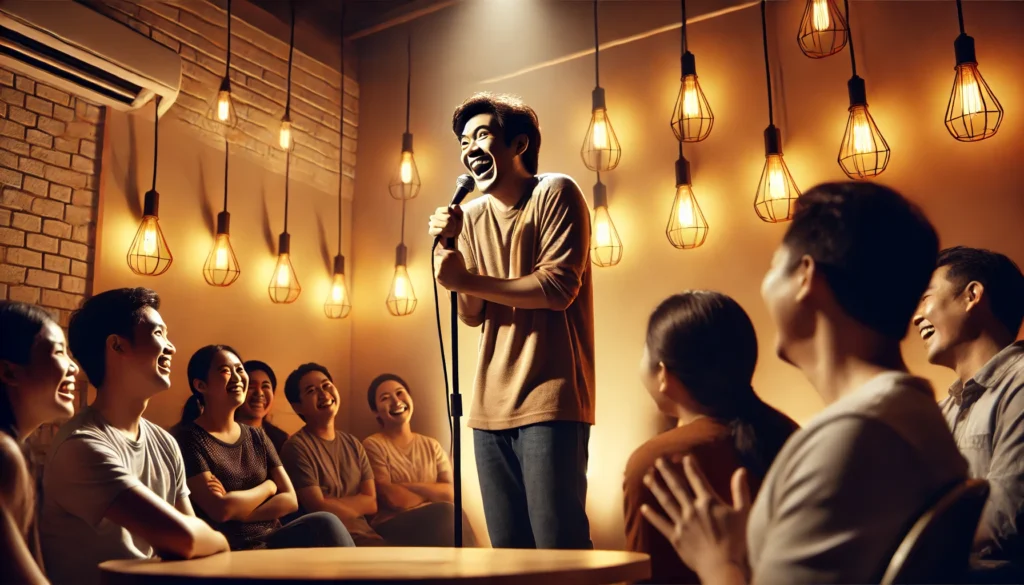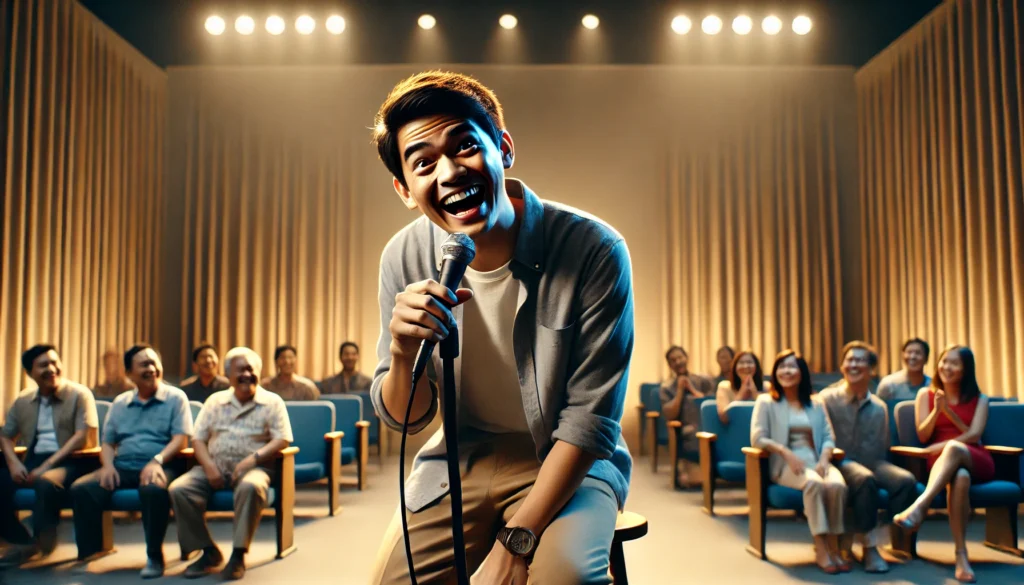Hey there, comedy enthusiasts! Ever wondered what’s cooking in the world of Filipino stand-up comedy? Well, buckle up, because we’re about to take a hilarious ride through the bustling streets of Manila’s comedy clubs and beyond. From side-splitting one-liners to gut-busting storytelling, Filipino comics are serving up laughter hotter than a steaming plate of sisig. So grab your favorite snack (maybe some chicharon?), and let’s dive into the world of Filipino stand-up comedy!
The Birth of Filipino Stand-Up: From Slapstick to Microphones
Alright, let’s start with a little history lesson – don’t worry, I promise it won’t be as boring as your high school textbooks. Filipino humor has been around since, well, forever. But stand-up comedy? That’s a relatively new kid on the block.
From Vaudeville to Variety Shows
Back in the day, Filipino comedy was all about slapstick and variety shows. Think of it as the great-grandparent of stand-up. Comedians would dress up in outrageous costumes, make funny faces, and pratfall their way into the audience’s hearts. It was physical, it was loud, and it was about as subtle as a karaoke machine at 2 AM.
But as the world changed, so did Filipino humor. With the rise of American influence and the spread of global pop culture, Filipinos started getting a taste for a different kind of comedy. They wanted something more, something that could make them laugh and think at the same time. Enter stand-up comedy, stage left.
The Stand-Up Revolution
The early 2000s saw the first whispers of a stand-up scene in the Philippines. Brave souls started grabbing microphones and telling jokes without the safety net of costumes or dance numbers. It was like watching a baby take its first steps – a bit wobbly, occasionally falling flat on its face, but undeniably exciting.
These pioneers faced an uphill battle. They had to convince audiences that a person just talking could be as funny as a guy in a dress falling into a pool. But slowly, surely, they started winning people over. One punchline at a time, they built the foundations of what would become a thriving comedy scene.
The Rise of Comedy Clubs: Where Laughter Meets Lapu-Lapu
As stand-up comedy began to take root in the Philippines, it needed a home. Enter the comedy club – a magical place where jokes flow like San Miguel beer and laughter is the only currency that matters (okay, you still have to pay for your drinks, but you get the idea).
Comedy in Manila: More than Just Traffic Jokes
Manila, the beating heart of the Philippines, quickly became the epicenter of the stand-up scene. Comedy clubs started popping up faster than you could say “Ano ba ‘yan?” (What the heck?). These weren’t just any old bars with a microphone in the corner. Oh no, these were dedicated spaces where comedy was the main course, served with a side of witty banter and a sprinkle of self-deprecation.
Places like Comedy Manila and The Library Comedy Bar became the breeding grounds for new talent. Aspiring comics could test their material, bomb spectacularly, and then come back the next week to try again. It was like comedy boot camp, but with more alcohol and fewer push-ups.
Beyond the Capital: Comedy Goes Nationwide
But the laughter couldn’t be contained in Manila alone. Like a virus (the good kind, not the “oh-no-we’re-in-a-global-pandemic” kind), stand-up comedy began to spread across the archipelago. From Cebu to Davao, comedy clubs and open mics started sprouting up, giving voice to local humor and regional quirks.
This nationwide expansion wasn’t just good for aspiring comedians – it was great for audiences too. Now, people all over the Philippines could experience the joy of live stand-up without having to brave Manila’s infamous traffic. It’s like they say: if Mohammed won’t come to the mountain, bring the mountain to Mohammed. Or in this case, if the provinces won’t come to the comedy, bring the comedy to the provinces!
The Comedians: From Newbies to Netflix
Now, let’s talk about the real stars of the show – the comedians themselves. These brave souls who dare to stand in front of a crowd and say, “Hey, I think I’m funny. Let me prove it to you.”
The Pioneers: Paving the Way with Punchlines
Every movement needs its trailblazers, and Filipino stand-up comedy is no exception. Comedians like Rex Navarrete and Jo Koy might be based in the US, but they played a huge role in putting Filipino comedy on the map. They showed that Filipino humor could translate to an international stage, paving the way for local comedians to dream big.
On the home front, comics like Allan K and Super Tekla transitioned from traditional comedy to stand-up, bringing their established fan bases with them. They were like the comedy equivalent of training wheels, helping audiences get used to this new form of entertainment.
The New Wave: Fresh Faces, Fresh Laughs
As the 2010s rolled around, a new generation of Filipino stand-up comedians emerged. These young guns came armed with sharp wits, observational humor, and a willingness to tackle topics that would make their parents blush.
Comedians like GB Labrador, Alex Calleja, and Victor Anastacio became household names, at least in households that enjoyed a good laugh. They brought a fresh perspective to Filipino comedy, tackling everything from politics to pop culture with a uniquely Filipino twist.
And let’s not forget the ladies! Female comedians like Gigi Holliday and Red Ollero proved that funny has no gender. They brought a much-needed female perspective to the male-dominated world of stand-up, cracking jokes about everything from dating disasters to the joys of being a tita.
The Content: What Makes Filipinos Laugh?
Now that we’ve got the who and the where, let’s talk about the what. What exactly are these comedians joking about that’s got Filipinos rolling in the aisles?
The Classic Hits: Family, Food, and Filipino Quirks
Some topics are universal in Filipino comedy. Family is always a goldmine – from overbearing mothers to that one weird tito (uncle) who always shows up drunk at family gatherings. Food is another favorite. After all, in a country where “Have you eaten yet?” is a standard greeting, you know there’s going to be some food-related humor.
Then there are the uniquely Filipino quirks. The obsession with karaoke, the complex social dynamics of “utang na loob” (debt of gratitude), the creative ways we use “ano” (what) in every other sentence – all of these become comedy gold in the hands of a skilled stand-up.
Breaking New Ground: Taboos and Social Commentary
But Filipino stand-up isn’t all light-hearted fun and games. As the scene has matured, comedians have started tackling more controversial topics. Politics, religion, sex – nothing is off-limits anymore. It’s like watching a tightrope walker without a safety net – thrilling, a bit scary, but you can’t look away.
This willingness to push boundaries has allowed Filipino stand-up to evolve into a powerful form of social commentary. Comedians are using their platforms to shed light on issues like corruption, social inequality, and cultural taboos. They’re making people laugh, sure, but they’re also making them think. It’s like sneaking vegetables into a kid’s meal – the audience is getting something nutritious along with their entertainment.
The Challenges: It’s Not All Laughs and Giggles
Now, before you quit your day job to become the next Filipino comedy sensation, let’s talk about some of the challenges facing the industry. Because, let’s face it, making people laugh for a living isn’t always as fun as it sounds (okay, it’s still pretty fun, but you know what I mean).
The Economics of Laughter: Making Ends Meet
Here’s a shocking revelation: most stand-up comedians aren’t rolling in dough. I know, I know, it’s hard to believe that telling jokes doesn’t immediately lead to a life of luxury. But the truth is, making a living solely from stand-up comedy in the Philippines is tough.
Many comedians have to juggle their comedy careers with day jobs. It’s not uncommon to see a comedian killing it on stage one night, then heading to their office job the next morning. It’s like being Clark Kent and Superman, except instead of fighting crime, you’re fighting to pay the bills.
The Cultural Tightrope: Balancing Humor and Sensitivity
Another challenge Filipino comedians face is navigating the complex cultural landscape of the Philippines. In a country with diverse ethnic groups, religions, and social classes, it’s easy to accidentally step on toes. Comedians have to walk a fine line between being edgy and being offensive.
This balancing act is made even trickier by the rise of social media. One poorly received joke can lead to a Twitter storm faster than you can say “viral.” It’s like walking through a minefield, except the mines are easily offended netizens armed with hashtags.
The Future: Where Does Filipino Stand-Up Go From Here?
Alright, time to dust off my crystal ball and peer into the future of Filipino stand-up comedy. Spoiler alert: it’s looking pretty bright (and funny)!
Going Global: Filipino Humor on the World Stage
As of 2018, Filipino comedians were starting to make waves internationally. With the rise of streaming platforms and social media, it’s becoming easier for Filipino comics to reach a global audience. Who knows? The next big international comedy star might be cracking jokes in Tagalog right now.
Digital Domination: Comedy in the Age of Social Media
The future of Filipino stand-up is likely to be increasingly digital. We’re already seeing comedians build huge followings on platforms like YouTube, Facebook, and TikTok. These platforms allow comics to reach audiences far beyond the walls of comedy clubs, potentially turning local favorites into national (or even international) stars overnight.
Diversity and Inclusion: A Broader Range of Voices
The future of Filipino stand-up is also likely to be more diverse. As the scene continues to grow, we’re bound to see a wider range of voices and perspectives on stage. More women, more LGBTQ+ comics, more comedians from different regions and backgrounds – all bringing their unique experiences and humor to the mic.
The Last Laugh
So there you have it, folks – a whirlwind tour of the Filipino stand-up comedy scene. From its humble beginnings to its promising future, it’s been quite a ride. And the best part? This is just the beginning. The Filipino stand-up scene is like a teenager – it’s grown a lot, but it’s still got some awkward phases to go through before it fully matures.
But one thing’s for sure – Filipino stand-up comedy is here to stay. It’s more than just a form of entertainment; it’s a mirror reflecting the joys, struggles, and quirks of Filipino society. It makes us laugh, it makes us think, and sometimes, it makes us laugh so hard we cry (or is that just me?).
So the next time you’re in the Philippines (or if you’re already there, lucky you!), why not check out a local comedy show? Who knows – you might just witness the next big thing in comedy. And if not, well, at least you’ll have a good laugh. After all, isn’t that what it’s all about?
Here’s a quick summary of the key points we’ve covered:
| Aspect | Description |
|---|---|
| Origins | Evolved from slapstick and variety shows in the early 2000s |
| Key Locations | Started in Manila, spread nationwide |
| Notable Pioneers | Rex Navarrete, Jo Koy, Allan K, Super Tekla |
| New Generation | GB Labrador, Alex Calleja, Victor Anastacio, Gigi Holliday, Red Ollero |
| Popular Topics | Family, food, Filipino quirks, social issues |
| Challenges | Economic viability, cultural sensitivity |
| Future Trends | International expansion, digital platforms, increased diversity |
Remember, in the world of Filipino stand-up comedy, the punchline is always “To be continued…” So stay tuned, keep laughing, and who knows? Maybe the next time you hear a great Filipino joke, it’ll be one you read about here first!
Disclaimer: This blog post is based on information available up to 2018. The comedy scene may have evolved since then. While we strive for accuracy, some details may have changed. If you spot any inaccuracies, please let us know so we can update our information faster than a comedian can say “Knock knock!”




